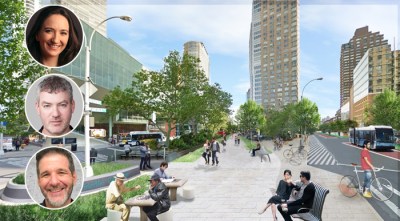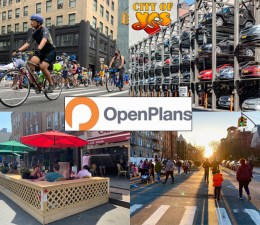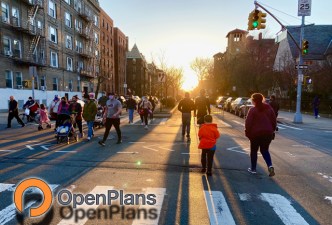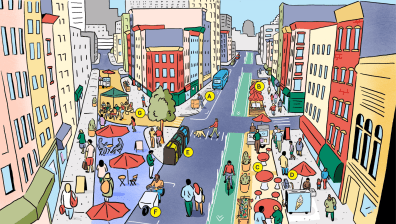Opinion: Open Plans Lays Out Its ‘Joyful, Sustainable’ Future for a People-Centered NYC
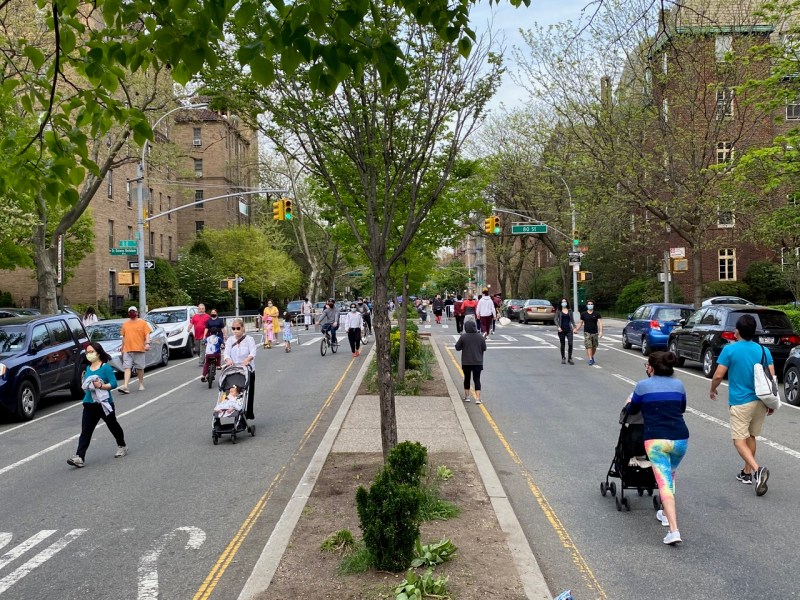
This year could be a watershed moment in the effort to make our city and state more livable — but only if our government acts upon it. Open Plans’s vision for the future of New York is joyful, sustainable, interconnected, and people-centered. Achieving it will require coordinated action on multiple fronts; our newly released legislative agenda calls for just that.

We believe there must be swift and decisive action on four key fronts: making our streets more livable, reforming the way we manage our curb, fostering joyful and equitable public spaces, and eliminating parking mandates. In this effort, it will be essential that the city, state, agencies, and the administration share responsibility and work together to make our city more livable for all.
Make streets livable
Livable streets are vibrant places where people feel at home — neighbors foster community, children can safely bike or walk to school, and seniors can comfortably travel around their neighborhood. Nearly every aspect of a city can impact livability: street design, transit, greenery, lighting, housing, benches, sanitation, and much more.
We can’t build a livable city without reclaiming space from cars, and we’ll never do that unless we reduce driving. Legislation can help by tackling the incentives that encourage people to drive, ending entitlements that prioritize drivers’ needs in public space, and providing safe and reliable alternatives to car travel. The city has a responsibility to mitigate the number of non-essential vehicles in its fleet; agencies should encourage their employees to take transit by providing sufficient reimbursement or benefits, and utilize alternative forms of transport, like cargo bikes, to take the place of cars in the fleet. Taking on parking placard abuse (Intro 500), providing a rebate for e-bike purchases (S3080A/A516), and redesigning the truck route (Intro 708) will all help to make our streets more livable.
Getting people out of cars also requires that they have access to realistic alternative modes of transit. The City should expand its shared micromobility programs and infrastructure citywide (dockless bikes and scooters would allow rapid expansion), and the state should encourage e-bike usage by creating the Ride Clean Rebate program (S3080A/A516). Additionally, the city must deliver on its promise of more bus lanes, and Council members should champion these projects in their districts.
Additionally, people will never feel truly able to enjoy our streets as public space unless they feel safe. Both the State and City have a role to play in making our streets safer. Heavier vehicles are significantly more deadly than their lighter counterparts, so the State should enact a tax on vehicles over a certain weight. The state legislature should also pass the bills included in the SAFE Streets Act to help ensure that all road users are safe.
Daylighting all intersections in New York City — which is required by New York State, but the city refuses to implement it — is a proven way to make our streets much safer. We can begin by passing Intro 854 to daylight at least 100 intersections annually.
Reform and manage the curb
Livable streets are most joyful and safe when the curb is well-managed. The curb is valuable public space and should be treated as such, rather than being dedicated almost exclusively to free parking.
The city should explore widespread metered dynamic pricing to place appropriate value on this use of public space. Shifting a portion of New York’s free parking to metered would generate at least $1 billion in revenue for the city, reduce congestion, and increase turnover at the curb.
As e-commerce and other deliveries create increasing activity at the curb, we need more loading zones; the city should meet the requirements legally mandated by the Streets Plan and dramatically expand both commercial and neighborhood loading zones.
We should also allow community-based organizations to easily use their curb space for outdoor events, experiences, and programming by passing Intro 293. And New York can catch up with other cities and nations by continuing to iterate on our trash containerization pilot and making it permanent.
One of the most crucial uses for our curb is a strong and well-managed Open Restaurants program. By amending and then passing Intro 31, we can create a permanent Open Restaurants program managed by the Department of Transportation, codify standardized rules for “streateries,” and ensure small businesses can stay in the program by making it year-round (negating the need for expensive storage space in the winter months).
Furthermore, DOT should create a curb management strategy — a holistic review of curb management regulations and policies — and the City Council should establish New York City as a leader in the curb management space by requiring a publicly accessible digital curb inventory. This would catalog and map all the uses at the curb in New York City in a publicly accessible, standardized format, which is something no city has done yet at scale.
Utilizing our curb for all these public uses is only viable with robust enforcement tools. Without them, many of these new curb programs will end up strained and gutted by misuse. In fact, our streets feel chaotic and lawless right now because the rules are so rarely enforced. Intro 501 would create a new civil violation for obstructing vital areas of the road and allow everyday people to easily report these infractions, which would help disrupt the culture of cars having free reign to park or idle wherever, whenever.
Embracing new technology to expand automated enforcement of the curb would be even more effective, helping to establish new uses and incentivizing good behavior. But right now, New York City needs permission from Albany to use this technology. There are bills, S1398A/A10446 and S8992/A10336, that would allow some camera-based enforcement in bike and bus lanes respectively that should be made law, but a more comprehensive bill must be passed if we are to enforce the various uses at the curb. Albany should pass these bills and the City Council should pass a home rule message with the mayor’s support.
Better manage our public space
It is also the responsibility of the government to create and facilitate safe and joyful public spaces. The “New New York” panel’s recommendation for a Director of the Public Realm is a good first step, but there’s much more we need to do. Establishing a full Office of Public Space Management would signify an intention to create well-managed, joyful public spaces.
Furthermore, the city should hire local public space managers to better manage neighborhood-level public spaces. Our current ad-hoc approach to local management, which works best in neighborhoods with the resources to undertake public space improvements on their own, is inequitable and unjust. City-employed, local-level public space managers could focus on cultivating equitable public space rather than what’s easiest or most convenient.
The city can empower communities to create public spaces in their community, too. As it stands, public space partners are required to carry expensive and onerous general liability insurance to carry out their work. The city should take on this insurance burden and indemnify these partners to increase the equity and accessibility of public space.
Open streets is a prime example of what can happen when New Yorkers come together to create joyful public spaces; the City can pursue new ways to foster this movement. The Council should provide additional funding support for groups putting on open streets programming, the city should remove burdensome Street Activities Permit Office requirements that serve as a barrier to programming on open streets.
And Summer Streets should be expanded to Brooklyn and Queens, initially, and then to the Bronx.
Eliminate parking mandates
Finally, both on-street and off-street parking incentivizes driving and must be addressed as a system. While curb management can reform on-street parking, the City must also remove onerous off-street parking mandates, which require a minimum number of required parking spots in every new development.
These mandates encourage New Yorkers to drive by providing a private, designated space for their car, contributing to congestion, unsafe streets and the climate crisis. They also raise rents, contributing to our housing crisis, and force those without cars — often lower-income residents — to subsidize the cost of parking for others.
Other cities around the country — Buffalo, San Francisco, Raleigh, and dozens more — have eliminated parking mandates entirely. New York has a chance to catch up in the proposed City of Yes zoning text amendment.
It’s critical that we eliminate these costly parking mandates citywide. A half-measure like merely expanding the transit zone (the current area where parking mandates are removed or lessened) is a far cry from what we need to solve our transportation and housing crises. This text amendment is a once in a generation opportunity to get this reform passed and we must do it right.
In order to enact transformational change, we need concentrated and coordinated action at all levels of government. Ensuring New York City remains the greatest city in the world requires intention, innovation, and new ideas; we’re working to foster those in a holistic and interconnected way. We’re looking forward to working this year towards a more people-centered city for everyone.
Sara Lind is the Chief Strategy Officer at Open Plans and Michael Sutherland is the group’s Policy Analyst.
